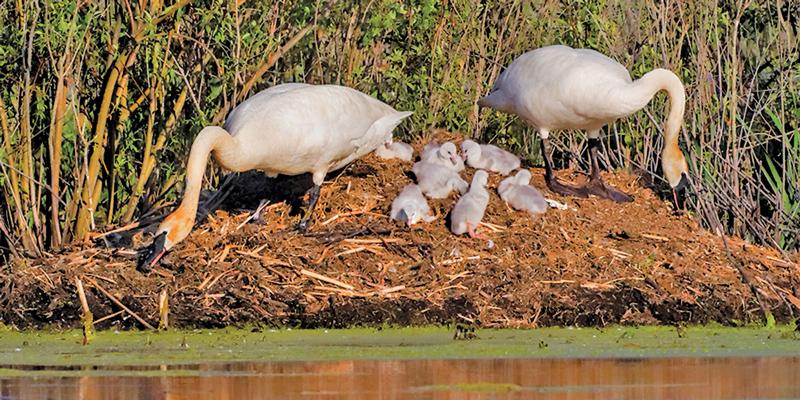“[T]he boy’s mind was full of the wonder of what he had seen. Not many people in the world have seen the nest of a Trumpeter Swan … Nothing he had ever seen before in all his life made him feel quite the way he felt, on that wild little pond, in the presence of those two enormous swans.”
–E. B. White, The Trumpet of the Swan
Unlike the boy in White’s book, we need not travel to a remote Canadian wilderness to see this spectacular native bird with feathers the color of freshly fallen snow. City ornithologist Juliet Berger tells us that trumpeters are more abundant in Washtenaw County than anywhere else in southeast Michigan.
Their trumpeting voice is like no other bird sound we have heard, but even when they aren’t vocalizing, trumpeters are easy to identify. Adults often weigh more than twenty-five pounds with a wingspan around seven feet. Their white feathers–sometimes stained a light rusty color on the head and neck from feeding on submerged plants–are complemented by black legs and feet and glossy black bills.
Their sounds and bills distinguish trumpeters from the other big white swan that is resident here. Mute swans aren’t mute, but they certainly don’t trumpet, and their bills are orange, with large black knobs close to the head.
Although mute swans are gorgeous, graceful birds, the DNR is working to severely reduce their numbers. They are an invasive and aggressive species, destroying habitat and harassing trumpeters.
The DNR is especially solicitous about trumpeters because hunters, perhaps abetted by shrinking habitat, once wiped them out in Michigan and most of the country. They were reintroduced here in the 1980s using eggs gathered from zoos and a sanctuary in Alaska. By 2015, the U.S. Fish and Wildlife Service’s North American Trumpeter Swan Survey estimated that there were 3,000 adult and sub-adult swans in Michigan.
“The return of the trumpeter swan is a remarkable story of how to bring a species back from the brink of extinction,” says Margaret Smith, executive director of the Trumpeter Swan Society. However, they remain “a species of special concern” in the state, which is why the DNR seeks to protect them.
We hope trumpeter chicks (called “cygnets”) may show up at one of the ponds at the corner of Scio Church and Parker and perhaps elsewhere locally this month. Our image that includes cygnets was taken toward the end of May several seasons ago at the same corner. In April a new pair of swans appeared to be settling in the area.
Unfortunately, swan families at this corner have twice been struck by vehicles, one incident some time ago, apparently accidental, and a more recent one, in what is thought to have been an intentional act. The trumpeters loaf on the gravel shoulders and slowly cross the road to get from one pond to another. They exhibit no awareness of any danger. Please drive carefully in this area.
You may also see trumpeters on the river along Huron River Dr., including upstream and downstream from Foster Bridge and Barton Dam, in Gallup and Furstenberg parks, and in South Pond Nature Area, as well as on Thurston Pond. Look for these black-billed, snow-white giant birds on the water, along the shore, or in flight.


